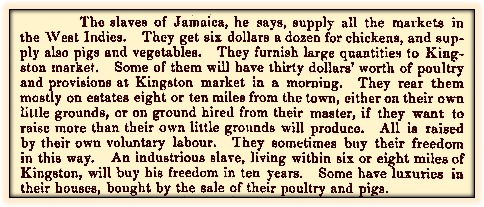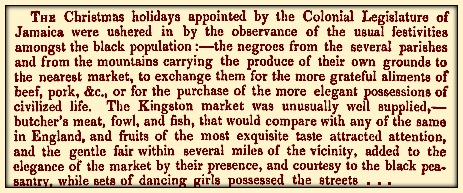the market
There was a market at the bottom of King street on the waterfront,
in some form, from the early 18th century until the 1960s, when it
was destroyed in the redevelopment of the waterfront.
from The History of Jamaica, Edward Long, 1774
At the bottom of the town, near the water-side, is the market place which is plentifully supplied with butchers meat, poultry, fish, fruits, and vegetables of all sorts. Here are found not only a great variety of American, but also of European, vegetables; such as pease, beans, cabbage, lettuce, cucumbers, French beans, artichokes, potatoes, carrots, turnips, radishes, celery, onions, &c. These are brought from the Liguanea mountains, and are all excellent in their kind. Here are likewise strawberries, not inferior to the production of our English gardens; grapes and melons in the utmost perfection; mulberries, figs, and apples, exceedingly good, but in general gathered before they are thoroughly ripe. In short, the most luxurious epicure cannot fail of meeting here with sufficient in quantity, variety, and excellence, for the gratification of his appetite the whole year round The prices are but little different from those of Spanish Town; but, where they disagree, they are more reasonable at Kingston, the supplies being more regular, and the market better superintended by the magistracy. The beef is chiefly from the pastures of Pedro's in St Anne; the mutton, from the Salt-pan lands in St Catharine; what they draw from the penns in St Andrew's parish being very indifferent meat.
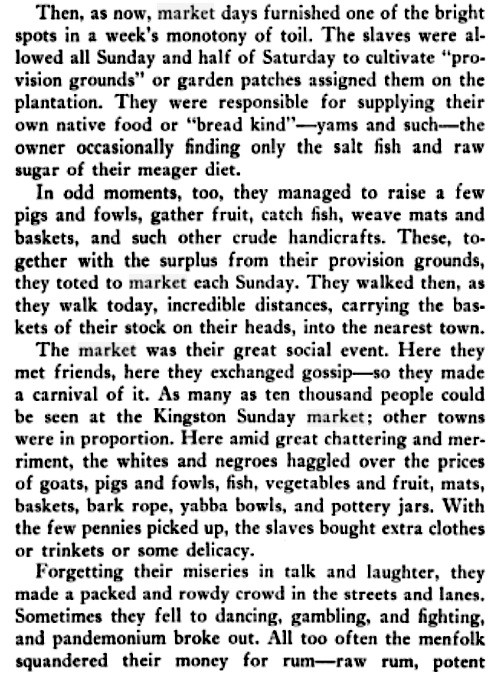

who provided the produce for the market?
particular produce:
Akee was one of the seasonal items readily available in the market:
The flora of Jamaica: a description of the plants of that island, arranged according to the natural orders, Volume 1
James Macfadyen, 1837
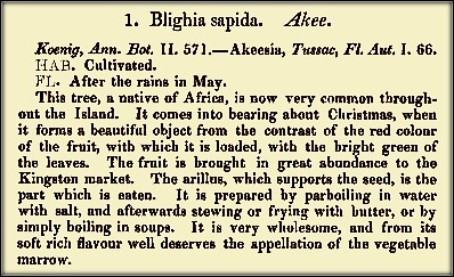
descriptions over the years:
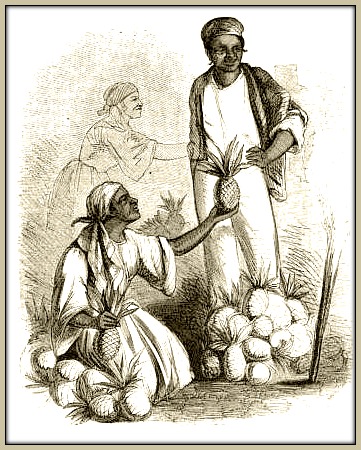
Harper's new monthly magazine, Volume 22, 1861
The market-place is a feature of Kingston — let no visitor fail to see it. If any thing can give us an idea of the confusion of tongues at Babel, it is this. Some fifty or sixty women squat upon the ground, with piles of fruit and vegetables before them. They do not wait patiently for purchasers, but address themselves vehemently to the throng, and extol the superior quality of their merchandise. Yet, with all its savage peculiarities, the scene is picturesque and attractive. A ruddy glare from a score of torches checkers the crowd with patches of fitful light — illuminating, here and there, a group of dusky Creoles, and leaving the rest in a blacker shade than night itself. . . . Any one of the groups in this market crowd, seen by torchlight, is quite an artistic study. The easy attitude of all: the men in their white shirts and trowsers; the women dressed also in white, and with the inevitable kerchief twisted, not ungracefully, round their heads. I have seen tamer pictures. Then the marvelous piles of fruit! How they are all sold is a mystery that I could not fathom. Such quantities of cocoas, pines, oranges, mangoes, grenadillas, sapodilloes, and vegetables of all descriptions — comparatively valueless in Kingston, but worth a mint if they could be taken to a Northern market. — Fruit, indeed, is about the only thing that one can buy cheap in Jamaica. All other necessaries and luxuries are enormously high.
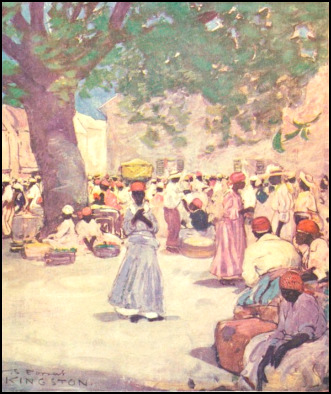
Archibald Stevenson Forrest, 1906
Jamaica Market
Agnes Maxwell Hall, c1942
Honey, pepper, leaf-green limes,
Pagan fruit whose names are rhymes,
Mangoes, breadfruit, ginger-roots,
Granadillas, bamboo-shoots,
Cho-cho, ackees, tangerines,
Lemons, purple Congo-beans,
Sugar, okras, kola-nuts,
Citrons, hairy coconuts,
Fish, tobacco, native hats,
Gold bananas, woven mats,
Plantains, wild-thyme, pallid leeks,
Pigeons with their scarlet beaks,
Oranges and saffron yams,
Baskets, ruby guava jams,
Turtles, goat-skins, cinnamon,
Allspice, conch-shells, golden rum,
Black skins, babel - and the sun
That burns all colours into one.


